Im-‘peck’-able Creatures
Woodpeckers are a family of birds that include flickers, sapsuckers, piculets, and wrynecks. They are well known for their foraging behaviour of pecking trees to hunt for insect prey, and their drumming can be heard from a distance away. Their diet can also include fruits, nuts, seeds, and even small animals and tree sap.
Knock Knock
Do you know why the woodpecker does not get a headache from pecking at wood with such speed and force?
The woodpecker has specially evolved to be able to drill into wood, with a special bone that acts like a seat-belt for its skull, called the hyoid bone. It starts in the mouth, wraps around the skull, and attaches between the eyes. This helps to protect the bird’s brain from the impact. The woodpecker also has sharp toes to grip onto the tree, with most of them having two toes at the front and two at the back, forming an ‘X’ shape.
Ecosystem Engineers
Besides pecking at wood for food, the woodpecker also uses this ability to excavate cavities in the tree trunks and branches for nesting or roosting. When a woodpecker abandons its cavity, other cavity-nesting species of birds will be make use of these ready-made holes, much like a BTO!
Thus, woodpeckers are important ecosystem engineers, which means that they significantly modify a habitat and have an impact on the resources available to other species.
There are eight species of woodpeckers in Singapore, with the Great Slaty Woodpecker (Mulleripicus pulverulentus) and Buff-rumped Woodpecker (Meiglyptes tristis) being rare non-breeding visitors. The White-bellied Woodpecker (Dryocopus javensis) is believed to be extirpated from Singapore with no recent records.
Here are the differences between the remaining five species of woodpeckers found in Singapore.
1. Sunda Pygmy Woodpecker
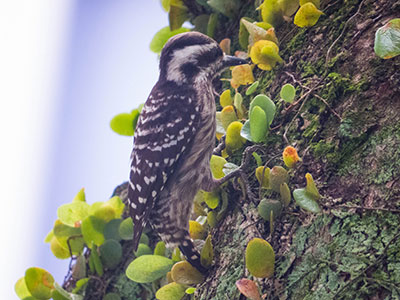
Photo credit: Tok Yin Xin
The Sunda Pygmy Woodpecker (Dendrocopus moluccensis) is the smallest species of woodpecker in Singapore. At about 12 to 13 cm, it is commonly found in our green spaces and other urban areas of Singapore.
It has an unmistakable plumage with brown and white streaks on the underside, brown and white barring on the upper side, with a brown cap, ear covers, and sub-moustachial stripe that is found on the feathers along the side of the bird’s lower jaw. The male has a reddish streak on the side of the crown, which is absent in the female.
2. Common Flameback
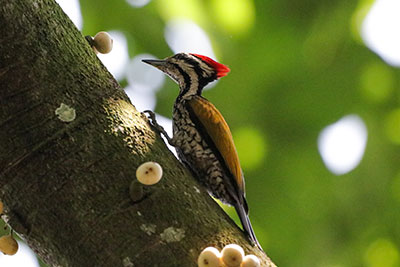
Photo credit: Benjamin Tan
The Common Flameback (Dinopium javanense) is a beautiful woodpecker with a golden-yellow back. The underparts are white with black scaling. Its head is white with a black eye-stripe and moustache. This species has a distinct crest; the male has a red crest, while the female has a black crest with white spotting.
It is commonly found in pairs, and can be seen in parks, gardens, forest edges, mangroves, and wooded areas. The Common Flameback is also known as the Golden-backed Three-toed Woodpecker, as it is different from other woodpeckers by having only three toes on each foot.
3. Laced Woodpecker
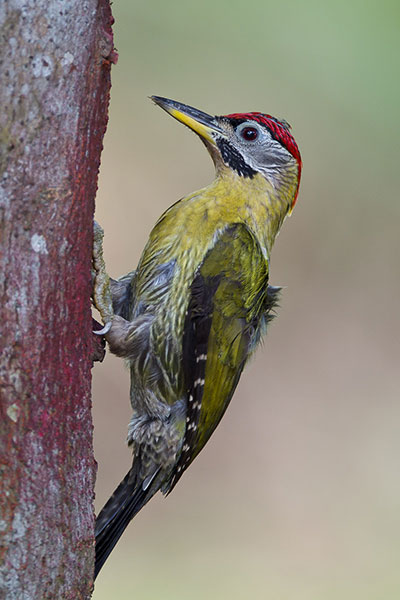
Photo credit: Francis Yap
The Laced Woodpecker (Picus vittatus) has olive-green upper parts, a black moustache, and a black- and white-scaled underside. The male has a red crown whereas the female has a black crown. At about 30 cm, this species is about the same size as the Common Flameback. This species is more commonly encountered in wooded areas.
4. Banded Woodpecker
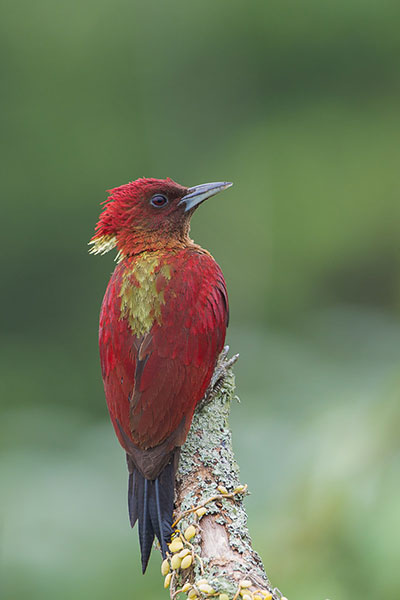
Photo credit: Francis Yap
The male Banded Woodpecker (Picus miniaceus) has a red crest and upperparts, yellow nape, with narrow bands on the underside. The female is less yellow, and has white spots on its face. This species, at about 26 cm, is slightly smaller than the Common Flameback and Laced Woodpecker, and can be found alone or in pairs. It is more commonly found in forests and secondary growth.
5. Rufous Woodpecker
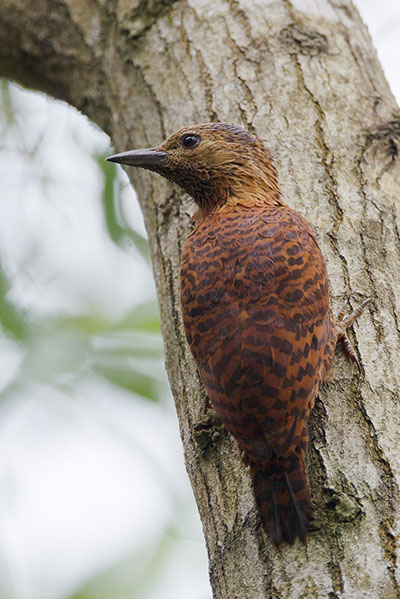
Photo credit: Francis Yap
The Rufous Woodpecker (Micropternus brachyurus) has an overall brownish red plumage, with narrow black bars on the wings, tail, and belly. It also has a lighter coloured throat with black bar. The male differ from the female by having a red patch below the eye. This uncommon species is about the same size as the Banded Woodpecker, and is found in wooded areas.
For more information
Love to bird-watch, or want to learn more on identifying garden birds? Join us for Garden Bird Watch, that runs twice a year as part of the NParks Community in Nature Biodiversity Watch series. Click here for more information.
For more information about bird species found in Singapore, please click here.





Have views or comments on this article? Let us know via this form. If you would like to give us feedback on any other areas relating to our parks and gardens, please submit via https://www.nparks.gov.sg/feedback